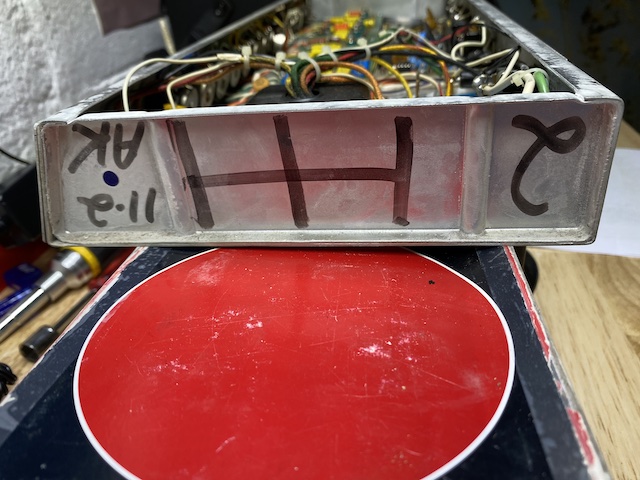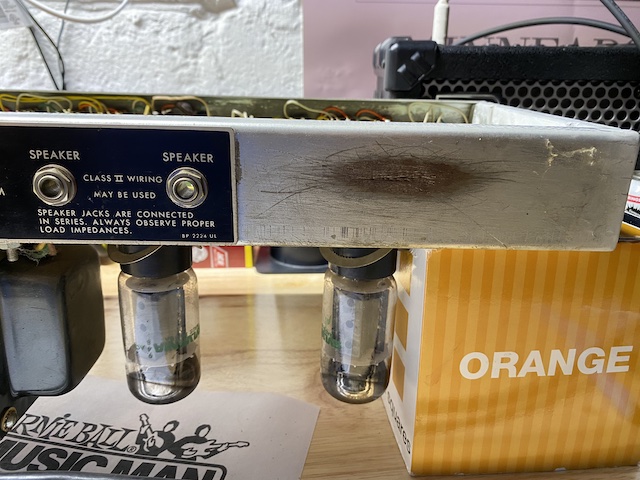I picked this up about 15 years ago and used it many hours since. Not much lately unfortunately. With some time being spent at home now I want to learn as much as I can about amps and maintenance/repair. Anyway, where better to start than the amp that has been with me through thick and thin.
The serial number has been chiseled off, and I promise that was not me! Chasis number badge is long gone. Everything appears to be original. I don't see any date codes on it or other spots where a serial number could have been. Hoping someone would be able to help me find out some details.
Questions:
-When was it made?
-What is the chassis number?
-What is this white powder on the inside of amp?
-In the attached photo, I circled a component. What is it and does it need replacement?
Stuff I know:
-I saw a youtube video from the Guitologist where he takes a HD130 apart and that model has many IC's where this one has 1 inside
-Has 11-2 AK written in marker on the side of chassis.
-Still has two USA made Sylvania tubes. What tubes did these originally ship with?
If anyone has any info that would be great! Any other details I am missing I can find out as its on the bench right now.





Information about your amp
Your amp is a Sixty-five Reverb head, chassis # 2275-65. They were produced between '74 and '79. Since your three-way power switch has "Standby" between "Hi" and "Lo" (and not "Off") and you don't have a 12AX7 phase inverter tube, yours is later production, likely '79. The two Sylvania green label 6CA7/EL34 power tubes look to be original.
As you probably know, AK are the initials of the tech who built it or QC'd it, on November 2nd. Sometimes there's a handwritten date and initials written in marker on the main board, see if you can find that.
The seven round metal things with eight legs are the TO-8 metal can transistors these amps used. Replaced in other models by the flat black opamps.
The white power could be anything. Oxidation from the chassis or some components? I would suggest carefully vacuuming it out if possible. I would not recommend inhaling or tasting it...
Don't see anything circled in any photo, please repost that one.
If you haven't worked inside amps before, there are certain safety precautions you must take to avoid serious injury - or worse. Are you familiar with discharging capacitors? Do you know the "keep one hand in your pocket" rule? If not, please don't do anything more than take photos for right now!
Also, how are your soldering skills?
Once you are ready, the typical maintenance you would perform is:
Replace the power filter capacitors in the "doghouse" (metal container screwed onto underside of chassis)
Replace all the inner chassis electrolytic capacitors (the blue tubular ones)
Pull all transistors (round metal cans) and the opamp and clean sockets with electronic cleaner, then reseat all
Pull tubes and clean sockets - retension sockets if tubes don't sit snugly when installed
Clean all jacks, switches, connectors and pots with electronic cleaner
Set amp bias correctly
Adjust tremolo strength/speed
Can provide you with list of components and where to get them, techniques, etc. if you decide to take this on.
None of it is difficult, just have to be organized and patient.
Good luck!
Oh wow, thanks for all that info!
This site is fantastic. Thanks for taking the time to reply.
I did attach a photo that was missing from the first post about a component that I had a question on. It looks well worn and rough feeling to the touch. Attached as well is a better photo of the tubes. As far as replacing tubes, would it be smart to replace those as they are 40 years old? Or continue to let them go until they fail?
As far as the next steps, I would love to tackle that maintenance list. And again thank you for giving me a list to work off. The design on these amps and other guitar amps has me hooked and I want to learn more...by doing. Soldering skills are on point from being in the broadcast engineering field, but that doesn't protect me from stupidity or rushed work. Thanks for the safety reminders.
If you have time send me that list of components and I will get to work. Whenever you have a second that is.
Screen Grid Bias
That looks like it is R63 1.5k 10W resistor that is used to bias the screen grids in the 2 output tubes.